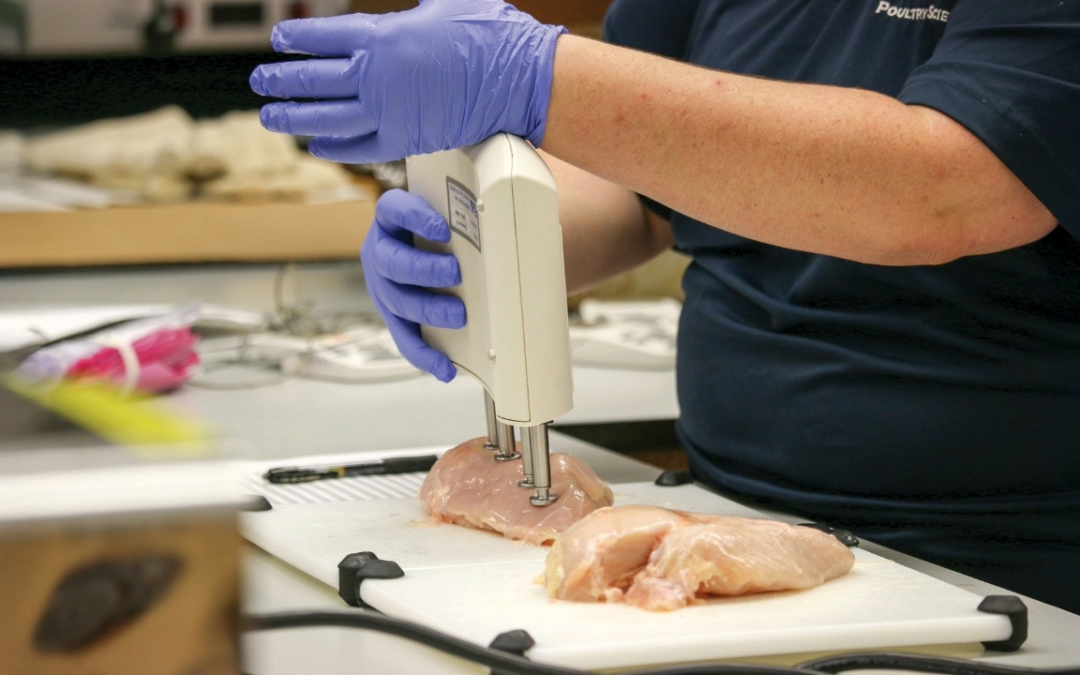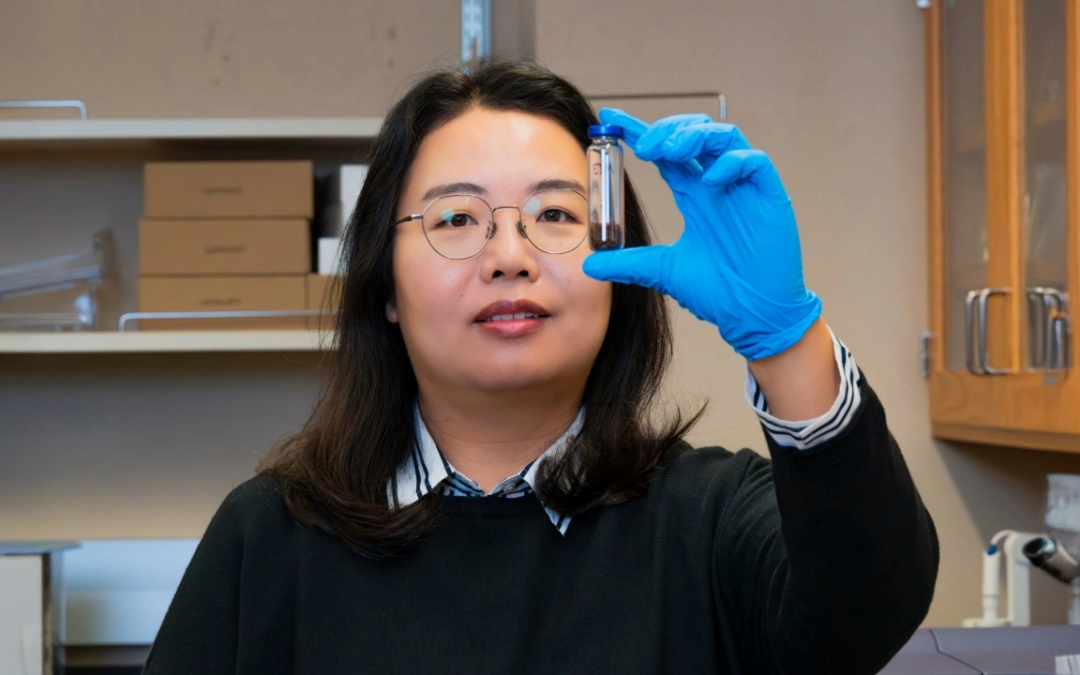
A new Auburn University funding program is providing shorter-term grants that address the most critical needs of Alabama agriculture.
By Paul Hollis
Long-term research is vital to the future of U.S. production agriculture, but farmers can’t always afford to wait for solutions to their most pressing problems. That’s why a new Auburn University funding program is providing shorter-term grants that address the most critical needs of Alabama agriculture.
“As a university, a significant amount of our focus is on long term,” says Paul Mask, assistant dean for extension in the College of Agriculture. “We’ve always tried to ensure that, down the road, farmers will have the tools and the innovative approaches they’ll need. But farmers have to survive in the short term, so it’s also critical that we provide answers to their short-term problems. It’s too risky for farmers to be doing this on their own.”
That’s where the Alabama Agricultural Experiment Station’s new Production Agriculture Research program, or PAR, comes in—examining and finding solutions to problems that are preventing producers from being profitable right now. Administered through the AAES with USDA National Institute of Food and Agriculture Hatch funding and matching state appropriations, the program is supporting 15 projects in its first year, with a total commitment of $622,000.
“We’ve invested a lot of AAES funds into ‘seed’ grants to address important research topics related to agriculture in Alabama, and that has been very beneficial,” says Henry Fadamiro, associate dean for research for the College of Agriculture and associate director of the AAES. “It allows faculty members to generate data that can then be used to write larger grants, and we’ve seen a high return on investment from this funding.”
But that program, he says, focused on agriculture in general and not specifically on production agriculture. PAR is a first of its kind for the AAES in that it focuses specifically on production agriculture, says Fadamiro,
“As we began to evaluate our grants program, we realized the need to create something that addresses the critical needs of our farmers and fills some of the gaps in our current research,” he says.
The projects being funded through the PAR grants program address needs identified by farmers, commodity groups and other agricultural stakeholders in Alabama.
“Many of these are combined research and extension projects,” Fadamiro says. “It’s applied research, in the sense that it will address a practical problem right away. Most of this work will be funded over two years with immediate deliverables, so the impact can more readily be documented for farmers and for Alabama agriculture.”
Immediate solutions for immediate problems
One of the critical research areas identified is target spot, an emerging disease in cotton. Target spot is responsible for yield losses of more than 20 percent in current commercial varieties, with combined losses in Alabama, Georgia and the Florida Panhandle totaling more than $70 million.
Jenny Koebernick, assistant professor in the Department of Crop, Soil and Environmental Sciences, is leading a project to develop a screening protocol that will detect the disease in the early growth stages of cotton and test to see if it is spread from soybeans to cotton.
“The disease survives over the winter on crop residue, and we don’t know if an infection in soybean spreads to cotton,” Koebernick says. “Currently, there are no resistant varieties to target spot in cotton, with the only defense against the disease being fungicide applications. The disease is hard to diagnosis, and spraying fungicides after symptoms already have appeared is too late.”
The first step in breeding a resistant variety is the ability to identify the disease on the plant. Koebernick’s research will evaluate varieties at the seedling stage in a growth chamber, providing prompt evaluation.
“This protocol allows rapid identification of genetic resistance which is the most effective form of disease control,” she says. “It will prevent yield loss and reduce costs associated with fungicide applications.”
In a related project, Austin Hagan, professor and extension specialist in the Department of Entomology and Plant Pathology, is looking at the response of new cotton varieties with advanced herbicide tolerance and Bacillus thuringiensis, better known as Bt, traits to target spot and fungicide inputs.
“Choosing a susceptible variety could leave producers exposed to sizable disease-related yield losses,” Hagan says. “While fungicides are a critical component of a target spot management program, additional information on optimum application timing and number, along with registered and experimental product efficacy, use of variable-rate irrigation systems for improved control and variety response to fungicides is needed to maximize the return from these costly inputs.”
In the area of animal science, Paul Dyce, assistant professor in the Department of Animal Sciences, is developing an early-detection assay utilizing metabolite-based biomarkers to minimize costs associated with over-selecting heifers and the resulting cull.
“We propose using an emerging technology, termed metabolomics, to develop a screening method that can identify highly reproductive heifers prior to entering the breeding colony,” Dyce says. “This technology could lead to a noninvasive blood test for heifer fertility and has the potential to improve production efficiencies for cow-calf producers.”
Another PAR project is using an innovative approach to investigate infertility in beef heifers. Infertility is a central limiting factor or efficient production systems in the cattle industry, but in beef cattle, pregnancy rates can be lower than 60 percent under natural breeding and lower than 50 percent when artificial insemination is used.
“We’re proposing a multidisciplinary research program in partnership, with three AAES research centers and the Alabama Beef Cattle Improvement Association, to investigate infertility in beef heifers with an innovative approach using phenotypic parameters and gene transcript levels from peripheral white blood cells as predictors of a heifer’s pregnancy outcome,” says Fernando Biase, the animal sciences assistant professor leading the study.
Brenda Ortiz, crop, soil and environmental sciences associate professor and extension specialist, is leading a multifaceted research project to evaluate and demonstrate several practices in a comprehensive approach to irrigation water management.
“The practices of variable rate irrigation, sensor-based irrigation scheduling and deficit irrigation as well as the use of climate forecasts to support water withdrawal have not been demonstrated on-farm in Alabama prior to this research,” Ortiz says.
The following is a complete list of the 2017 PAR grants:
- Predictors of heifer infertility for enhancing beef production—Fernando Biase, assistant professor, Department of Animal Sciences.
- Modeling residual feed intake to improve herd feed efficiency—Terry Brandebourg, associate professor, Department of Animal Sciences.
- Metabolomic markers for selection of heifers with high reproductive potential—Paul Dyce, assistant professor, Department of Animal Sciences.
- Nitrogen delivery methods for stocker cattle grazing annual ryegrass: Russell Muntifering—professor, Department of Animal Sciences.
- Ventilation system to improve energy/water conservation for broiler growers—Jeremiah Davis, associate professor, Department of Poultry Science.
- Developing a novel mechanism to reduce food and quality loss of seafood and poultry—Amit Morey, assistant professor, Department of Poultry Science.
- Catfish farming in in-pond raceway system—Jesse Chappell, School of Fisheries, Aquaculture and Aquatic Sciences.
- Target spot management in cotton—Austin Hagan, professor, Department of Entomology and Plant Pathology.
- Breeding for disease resistance to target spot in cotton—Jenny Koebernick, assistant professor, Department of Crop, Soil and Environmental Sciences.
- Integrated management of bacterial spot disease on tomato/pepper—Neha Potnis, assistant professor, Department of Entomology and Plant Pathology.
- Assessing rootstocks for enhanced efficiency of peach production—Elina Coneva, professor, Department of Horticulture.
- Linking UAV remote sensing data to soybean water stress—Thorsten Knappenberger, assistant professor, Department of Crop, Soil and Environmental Sciences.
- Adoption of climate- and water-smart irrigation practices by Alabama farmers—Brenda Ortiz, associate professor, Department of Crop, Soil and Environmental Sciences.
- Production risks of Alabama agriculture—Ruiqing Miao, assistant professor, Department of Agricultural Economics and Rural Sociology.
- Sustainable epoxy adhesive for commodity strand board products—Brian Via, associate professor, School of Forestry and Wildlife Sciences.




